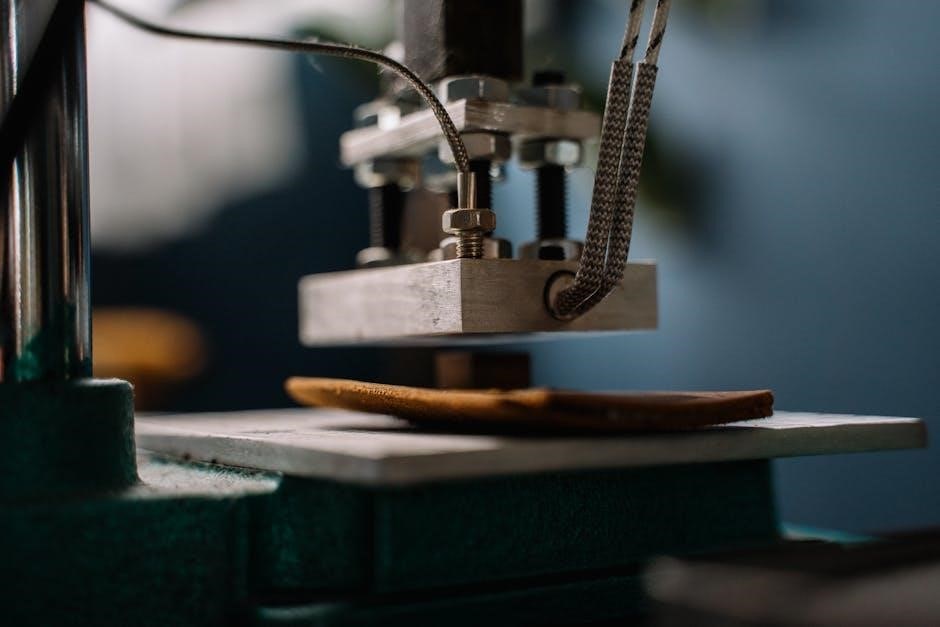Welcome to the comprehensive guide on ice maker manuals. This manual serves as an essential resource for understanding, installing, and maintaining your ice maker efficiently, ensuring optimal performance and longevity.

Understanding Your Ice Maker
An ice maker is an essential appliance designed to produce ice efficiently. Familiarize yourself with its parts, features, and types to ensure proper usage and maintenance for optimal performance.
2.1. Parts and Features
Understanding the parts and features of your ice maker is crucial for proper operation. Key components include the water reservoir, cooling system, and ice-making cycle. The control panel allows you to adjust settings, while the ice bucket stores freshly made ice. Advanced models may feature smart connectivity, enabling remote control via apps. Other features include ice size selection, self-cleaning modes, and low-water indicators. Familiarizing yourself with these elements ensures efficient use and maintenance of your appliance, optimizing its performance and longevity. Always refer to your specific model’s manual for detailed information on its unique components and functionalities.
2.2. Types of Ice Makers
Ice makers come in various types, each designed to meet specific needs. Portable ice makers are compact and ideal for small spaces, producing ice quickly without installation. Undercounter ice makers are built-in, offering a sleek, integrated look for kitchens. Nugget ice makers create chewable, pellet-style ice, popular for beverages. Flake ice makers produce soft, moldable ice, often used in commercial settings. Countertop ice makers are compact and movable, perfect for occasional use. Each type offers unique features, such as ice size selection or self-cleaning modes. Choosing the right type depends on your space, usage frequency, and preferred ice style. Refer to your manual for model-specific details and optimize your appliance’s performance based on its design.

Operating Instructions
Plug in the unit, connect the water supply, and use the control panel to select settings. Monitor ice production and empty excess water periodically for optimal performance.
3.1. Installation
Ensure the ice maker is placed on a level, stable surface away from direct sunlight and heat sources. Connect the water supply line to the designated inlet, following the manufacturer’s instructions. Secure all connections tightly to prevent leaks. Plug in the unit and allow it to cool for 24 hours before first use. Proper ventilation is essential to maintain efficiency and prevent overheating. Refer to the manual for specific model requirements, such as drainage setup or additional accessories. Double-check all connections and settings before operating. For built-in models, ensure correct alignment with surrounding surfaces. Testing the unit after installation ensures everything functions correctly.
3.2. Initial Setup
After installation, power on the ice maker and navigate to the control panel. Select your preferred language and unit of measurement. Set the ice size and production mode based on your needs. Check the water reservoir and ensure it’s filled to the recommended level. Run a cleaning cycle to purify the system before first use. Allow the unit to cool down for the specified time, usually 24 hours, to ensure optimal performance. Familiarize yourself with the display indicators, such as water level, ice capacity, and error alerts. For models with smart features, connect to your Wi-Fi and sync with the companion app. Review the manual for any additional setup steps specific to your model. Once initialized, your ice maker is ready to produce fresh, clear ice efficiently.
3.3. Daily Operation
Begin by turning on the ice maker and ensuring the water reservoir is adequately filled. Monitor the water level to avoid shortages. Select your desired ice size and production mode using the control panel. Allow the machine to reach the optimal temperature before harvesting ice. Regularly check the ice capacity to prevent overflow. Empty the ice bin when full to maintain efficiency. For models with smart features, use the app to schedule ice production or adjust settings remotely. Periodically inspect and clean the water filter to ensure clarity and taste. Always refer to your manual for specific operational guidance tailored to your model. Proper daily maintenance ensures consistent ice production and extends the lifespan of your appliance.
3.4. Custom Settings
Modern ice makers often feature customizable settings to tailor ice production to your preferences. Adjust the ice size and production speed for specific needs, such as small cubes for drinks or larger cubes for cooling. Many models allow scheduling ice production to coincide with your daily routine. Some advanced units enable temperature control to produce clearer or denser ice. Utilize smart connectivity to program settings via a mobile app, ensuring ice is ready when you need it. Experiment with energy-saving modes to balance production and power consumption. Custom settings may also include notifications for low water levels or maintenance reminders, ensuring seamless operation. These features enhance convenience and adaptability, making your ice maker more versatile for various occasions and preferences.

Maintenance and Care
Regular maintenance ensures optimal performance and longevity. Clean the ice maker thoroughly, descale to prevent mineral buildup, and check water filters for consistent ice quality and hygiene.
4.1. Cleaning
Regular cleaning is crucial for maintaining hygiene and performance. Start by turning off and unplugging the ice maker. Use a mixture of water and white vinegar to descale and remove mineral deposits. Wipe down the exterior with a damp cloth and mild detergent. For internal cleaning, run a cleaning cycle if available or manually clean the water reservoir, ice bin, and evaporator with a soft brush. Ensure all parts are rinsed thoroughly and dried to prevent mold or bacterial growth. Replace the water filter as recommended to maintain clean ice production. Cleaning regularly prevents odors and ensures fresh, clear ice. Always refer to your specific model’s manual for detailed cleaning instructions, as some parts may require special care. A clean ice maker operates more efficiently and lasts longer.
4.2. Troubleshooting
If your ice maker isn’t functioning properly, start by identifying common issues. Check if the water supply is turned on and the inlet valve is not clogged. Ensure the power cord is securely plugged in and the circuit breaker hasn’t tripped. If the ice maker is not producing ice, verify the water filter isn’t blocked or expired. For unusual noises, inspect the evaporator and fan for obstructions. If ice is too small or slushy, adjust the temperature settings or clean the condenser. Refer to your manual for specific error codes and solutions. Regularly descale the unit to remove mineral buildup. If issues persist, contact a professional technician. Troubleshooting early can prevent major repairs and extend the lifespan of your appliance. Always follow safety precautions when diagnosing or repairing your ice maker.
4.3. Regular Maintenance Tips
To ensure your ice maker operates efficiently, regular maintenance is crucial. Clean the interior and exterior regularly to prevent dust and bacteria buildup. Descale the unit every 3-6 months to remove mineral deposits, especially in hard water areas. Replace the water filter as recommended to maintain water quality and ice clarity. Check and clean the drain hose to prevent clogs. Inspect the condenser coils and fan for dust accumulation, as this can reduce efficiency. Ensure proper ventilation around the unit to maintain performance and energy efficiency. Finally, refer to your manual for specific maintenance schedules and guidelines tailored to your model. Regular upkeep will extend the lifespan of your ice maker and ensure consistent performance. Always follow safety precautions during maintenance to avoid damage or injury.

Safety Precautions
Always prioritize safety when operating your ice maker. Read the manual thoroughly before use to understand potential hazards. Ensure the unit is placed on a stable, level surface and keep it away from direct sunlight or heat sources. Never submerge electrical components in water or operate the ice maker near flammable materials. Avoid overloading the ice maker, as this can cause mechanical stress. Keep children away from the appliance and ensure they do not play with the ice or moving parts. Regularly inspect the power cord and water lines for damage or leaks. Never attempt to repair the ice maker yourself; consult a professional if issues arise. Proper ventilation is essential to prevent overheating. Always unplug the unit before cleaning or performing maintenance. Follow these guidelines to ensure safe and efficient operation. Your safety is paramount.

Energy Efficiency
Modern ice makers are designed with energy efficiency in mind, offering features that minimize power consumption while maintaining performance. Look for models with ENERGY STAR certification, as they meet strict energy efficiency standards. Proper installation and placement are crucial; ensure adequate ventilation to prevent overheating, which can increase energy use. Regular maintenance, such as cleaning filters and ensuring the water supply is not restricted, also improves efficiency. Adjusting settings, like ice size and production frequency, can help reduce energy usage. Refer to your manual for specific energy-saving tips tailored to your model. By following these guidelines, you can enjoy efficient ice production while lowering your energy bills. Energy efficiency not only benefits your wallet but also the environment. Always prioritize eco-friendly practices when using your ice maker.

Common Myths
Several misconceptions surround ice makers, often leading to confusion. One common myth is that distilled water is required for clear ice, but filtered tap water typically suffices. Another myth suggests that ice makers are energy-intensive, yet modern models are designed to be efficient. Some believe regular cleaning is unnecessary, but neglecting maintenance can lead to poor performance. Additionally, many think ice makers require professional installation, while most models are designed for DIY setup. Lastly, there’s a myth that ice makers are noisy, but advancements have made them much quieter. Always refer to your manual for accurate information and optimal use of your appliance.

FAQ
- Q: Where can I find the user manual for my ice maker?
A: Manuals are typically available on the manufacturer’s official website or provided with the product at purchase.
- Q: Why is my ice maker not producing ice?
A: Check water supply connections, ensure the ice maker is turned on, and refer to the troubleshooting guide in your manual.
- Q: Can I use tap water in my ice maker?
A: Yes, but filtered water is recommended to avoid impurities and ensure clear ice formation.
- Q: How often should I clean my ice maker?
A: Regular cleaning is essential for maintenance. Follow the cleaning instructions in your manual for optimal performance.
- Q: What if my ice maker makes noise?
A: Excessive noise may indicate improper installation or internal issues. Consult your manual or contact a technician.
Advanced Features
Modern ice makers offer smart connectivity, allowing remote control via apps. They also feature multiple ice sizes, self-cleaning modes, and quiet operation for enhanced convenience and efficiency.
9.1. Smart Connectivity
Advanced ice makers now feature smart connectivity, enabling seamless integration with smart home systems. Users can control their ice makers remotely through dedicated apps, scheduling ice production and monitoring levels in real-time. This feature also allows for custom notifications, such as when the ice bucket is full or when maintenance is needed. Some models even support voice commands via smart assistants like Alexa or Google Home. Smart connectivity enhances convenience, ensuring ice is always available without manual intervention. Additionally, it provides insights into energy usage, helping users optimize their appliance’s performance. This innovative technology transforms the ice-making process into a smarter, more efficient experience.
9.2. Special Modes
Modern ice makers often come equipped with special modes designed to cater to specific needs. One popular feature is the Fast Ice Mode, which accelerates ice production for urgent requirements. Another is the Eco Mode, which reduces energy consumption while maintaining performance. Some models include a Silent Mode, minimizing noise during operation, ideal for home environments. Additionally, certain high-end ice makers offer a Party Mode, increasing ice output to accommodate large gatherings. These modes enhance functionality, providing users with tailored solutions for various scenarios; By leveraging these features, you can optimize your ice maker’s performance to suit your lifestyle and preferences seamlessly.
Environmental Impact
Understanding the environmental impact of your ice maker is crucial for sustainable living. Modern ice makers are designed with energy efficiency in mind, reducing power consumption and minimizing their carbon footprint. Proper ventilation and maintenance ensure optimal performance, reducing unnecessary energy use. Additionally, using filtered water can reduce waste and extend the appliance’s lifespan. Regular cleaning and adhering to eco-friendly settings further contribute to environmental conservation. By following these practices, you can enjoy the benefits of your ice maker while promoting a greener lifestyle. Always opt for models with high energy ratings and eco-friendly features to make a positive impact on the environment.
Design and Usability
Modern ice makers are designed with usability and convenience in mind, featuring sleek and compact builds to fit seamlessly into any kitchen. Many models offer touch-sensitive controls and LED displays for easy navigation. The design often includes a portable structure, making it simple to move or place on countertops. Advanced ice makers incorporate self-cleaning modes and automatic shut-off features to enhance user experience. The transparent ice bucket allows for easy monitoring of ice levels. Additionally, many models are constructed with noise-reduction technology, ensuring quiet operation. These design elements ensure that ice makers are not only functional but also user-friendly, catering to a variety of needs and preferences.

Comparison Guide
When selecting an ice maker, it’s essential to compare models based on capacity, size, and efficiency. Portable ice makers are ideal for small spaces, while undercounter models offer a permanent solution. Nugget ice makers are popular for their chewable ice, whereas flake ice makers are better for cooling purposes. Compare features like ice production rate, noise levels, and energy consumption. Some models include advanced features such as smart connectivity or special modes. Consider your lifestyle and needs—e.g., frequent entertaining or outdoor use—to choose the most suitable type. This guide helps you evaluate options and make an informed decision, ensuring you find the perfect ice maker for your home or business.

Next Steps
Now that you’ve completed this guide, it’s time to put your knowledge into practice. Start by exploring additional resources, such as manufacturer-specific manuals or online forums, to deepen your understanding. Check for firmware updates to ensure your ice maker has the latest features. Experiment with custom settings to tailor ice production to your needs. Consider eco-friendly practices, like using filtered water, to reduce environmental impact. For long-term satisfaction, stick to regular maintenance routines and troubleshooting tips. Finally, share your experiences and tips with fellow users to build a supportive community. Happy icing, and enjoy the convenience of your ice maker for years to come!
Comments